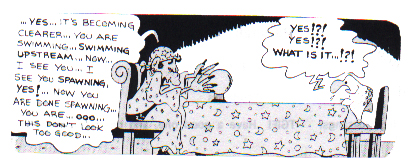 Marshall
Cultural Atlas Marshall
Cultural Atlas
This collection of student work is from
Frank Keim's classes. He has wanted to share these works for others
to use as an example of Culturally-based curriculum and documentation. These
documents have been OCR-scanned. These are available
for educational use only.
Animal Habitat Continues to
Vanish
Global warming is causing a lot of problems for
the land, the environment, and the animals. Since 10,000 years ago,
during the last ice age, the earth's temperature has risen five
degrees. It is hard to say which plant species will be able to keep
up with the fast changes in the environment. Rapid growing trees like
spruce can move across the land up to one hundred yards a year. Other
species of plants, like the slower evolving ones, only move a few
feet per decade. On the west coast, Edith's checkerspot butterfly has
already moved its course one hundred miles to the north, and entire
populations of sea life in Monterey Bay have moved north because the
water temperature is four degrees warmer than it was sixty years
ago.
Fresh water fish are being affected badly. Species
that depend on cold water, such as salmon, trout, walleye, pike, and
muskie, are in trouble because of a five degree rise in average water
temperatures. An Environmental Protection Agency study said that
twenty four states could lose fifty to one hundred percent of their
cold water fish populations.
Trees like the sugar maple could disappear from
the United States. With carbon dioxide doubling in the atmosphere,
the ranges of birch, hemlock, and beech trees could also shift 300 to
600 miles to the north. If that happens there would be large areas of
dead and dying trees left behind and they are fuel for a sudden
disaster of fires that would contribute to the atmosphere's heavy
carbon load and the result could be the destruction of even more
habitat. From 1981 to 1991 the start of springtime plant growth has
advanced by eight days in most of the United States. This could
affect some migrating birds and animals that go north to breed. If
the animals migrate too early they could end up not having enough
food and not reaching their breeding grounds. If they do make it they
will find a dangerously unknown environment. Other animals that are
being affected are the caribou and seals. The seal pups are dying
because their snow dens are collapsing and leaving them vunerable to
predators. Together with a reduction in the extent of pack ice, this
decline. in the seal population could leave polar bears with no
food.
Global warming is affecting everything and
everybody in one way or another. So people need to start watching
what they are doing to the environment, the land and the air we
breathe.
Charlotte
Alstrom

Christmastime Tales
Stories real and imaginary about Christmas, Slavik, and the New Year
Winter, 1996 |
Christmastime Tales II
Stories about Christmas, Slavik, and the New Year
Winter, 1998 |
Christmastime Tales III
Stories about Christmas, Slavik, and the New Year
Winter, 2000 |
| Summer Time Tails 1992 |
Summertime Tails II 1993 |
Summertime Tails III |
| Summertime Tails IV Fall, 1995 |
Summertime Tails V Fall, 1996 |
Summertime Tails VI Fall, 1997 |
| Summertime Tails VII Fall, 1999 |
Signs of the Times November 1996 |
Creative Stories From Creative Imaginations |
| Mustang Mind Manglers - Stories of the Far Out,
the Frightening and the Fantastic 1993 |
Yupik Gourmet - A Book of
Recipes |
|
| M&M Monthly |
|
|
| Happy Moose Hunting! September Edition 1997 |
Happy Easter! March/April 1998 |
Merry Christmas December Edition 1997 |
| Happy Valentine’s
Day! February Edition
1998 |
Happy Easter! March/April Edition 2000 |
Happy Thanksgiving Nov. Edition, 1997 |
| Happy Halloween October 1997 Edition |
Edible and Useful Plants of Scammon
Bay |
Edible Plants of Hooper Bay 1981 |
| The Flowers of Scammon Bay Alaska |
Poems of Hooper Bay |
Scammon Bay (Upward Bound Students) |
| Family Trees and the Buzzy Lord |
It takes a Village - A guide for parents May 1997 |
People in Our Community |
| Buildings and Personalities of
Marshall |
Marshall Village PROFILE |
Qigeckalleq Pellullermeng ‘A
Glimpse of the Past’ |
| Raven’s
Stories Spring 1995 |
Bird Stories from Scammon Bay |
The Sea Around Us |
| Ellamyua - The Great Weather - Stories about the
Weather Spring 1996 |
Moose Fire - Stories and Poems about Moose November,
1998 |
Bears Bees and Bald Eagles Winter 1992-1993 |
| Fish Fire and Water - Stories about fish, global warming
and the future November, 1997 |
Wolf Fire - Stories and Poems about Wolves |
Bear Fire - Stories and Poems about Bears Spring,
1992 |
|